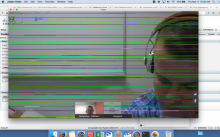Cisco Jabber Video For Telepresence 4.8 User Guide For Mac
New App on Apple Watch, with this App you can: * Check new chat messages * Reply a chat with Siri, emoticons, and pre-defined messages. * Answer/Decline/End a call * Mute/Unmute a call * Check recent calls * Call back from resents * Change your presence -Send broadcast IM to multiple contacts -Multiple Device Messaging (carbon copy to all connected Jabber clients) for cloud deployment -Select speaker as default audio output deviceSecurity enhancements -Stability improvements -Refer to Release notes for more details • 11.1.1 3 de nov de 2015.
Getting started The Jabber Video software client is usually made available to you by your organization's videoconference or IT administrator. See for detail on what is required for your computer to run Cisco Jabber Video for TelePresence (hereafter referred to as Jabber Video). A web camera, a microphone, and loudspeakers or a headset must be connected to your computer for Jabber Video to work correctly. See for more detail. • • • • • Signing in Your sign-in process may be automated by your administrator, and you may not even notice the sign-in screen. Otherwise, the administrator will supply you with a username and password. Procedure Step 1 Enter your username and password in the sign-in form.
Jabber Video will sign you in automatically from now on, unless you de-select Remember my Username, Remember my Password, and Sign in automatically Step 2 Click Sign in or press Enter. Quick setup This two-step dialog window pops up the first time you start Jabber Video and guides you through setting up your audio and video equipment. Step 2 provides an overview of expected outgoing video quality based on the available system resources. You can also access Quick Setup at any time by using the menu button. • • Audio and video selection Microphone The drop-down menu contains all microphones detected by Jabber Video.
A common scenario is that both your camera and your PC have built-in microphones. To test audio in: Procedure Step 1 Talk into your microphone to test whether the volume is within the recommended range. Step 2 Make adjustments as needed using the slider.
Video for TelePresence (Jabber Video), previously called Cisco TelePresence Movi ™, is a soft client that works with your PC or Mac to provide high-definition video communications from wherever you need to work - the airport. Cisco Jabber Video for TelePresence 4.8 User Guide for Mac OS X. Chapter Title. Using the info bar. PDF - Complete Book (2.55 MB) PDF - This Chapter (1.22 MB) View with Adobe Reader on a variety of devices.
Jabbervideo4.6.dmg (7) Cisco Jabber Video for TelePresence 4.8 User Guide for Mac OS X (10). When you use Jabber on your computer for calls, your computer becomes When the recipient answers, your video is displayed automatically to the caller. Cisco Jabber Video for TelePresence 4.8 User Guide for Mac OS X. Chapter Title. Using the info bar. Synnove williams. PDF - Complete Book (2.55 MB) PDF - This Chapter (1.22 MB) View with Adobe Reader on a variety of devices. Cisco Jabber Video For Telepresence User Guide Cisco Jabber Video for TelePresence (Jabber Video) is an application that The User Guide provides task-based information about end user operation.

If no sound is detected, the device may be muted. See for further advice on identifying and resolving audio issues.
Speakers The drop-down menu contains all speakers and headphones detected by Jabber Video. To test audio out: Procedure Step 1 Click Test to play a test sound that helps you determine whether the speaker volume is right for you. Step 2 Adjust using the slider. Note that multiple controls exist for volume settings. If sound is muted, too high, or too low, you may need to check hardware volume buttons for your devices, or the system settings. See for advice on identifying and resolving audio issues. Camera The drop-down menu contains all cameras detected by Jabber Video.
Procedure Step 1 Click the menu to change cameras. Step 2 Adjust the camera or your seating position so that your face is within the markers on the live preview. If you do not see a live camera preview: • Verify that a camera is properly connected to the computer.
• Make sure the privacy shutter is off and nothing is obstructing the camera. • Check whether another application is already using the camera.
Resource check Jabber Video calculates the estimated video quality you will be able to send from your computer based on the available resources. Expected outgoing video quality Your outgoing video quality will be classified as one of the following: • Excellent—your camera, computer, and network are capable of sending HD video. • Medium—the video sent is likely to be of medium quality. • Low—the video sent is likely to be of poor quality due to limited resources and/or camera capabilities. Actual quality of outgoing video during calls will vary. Note that what is received by the far end also depends on their incoming bandwith capabilities and system resources. Detail on the factors that impact video quality and how they are tested and classified by Jabber Video is provided below.
 No updates to FreeHand have been made for over four years, and Adobe has no plans to initiate development to add new features or to support Intel-based Macs and Windows Vista. Note: Freehand does not work with Mac OS X 10.6 or higher.
No updates to FreeHand have been made for over four years, and Adobe has no plans to initiate development to add new features or to support Intel-based Macs and Windows Vista. Note: Freehand does not work with Mac OS X 10.6 or higher.